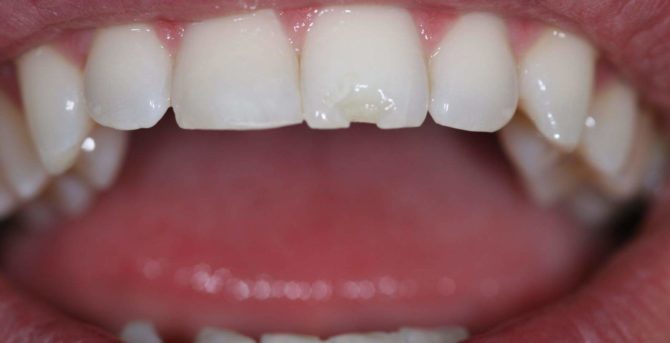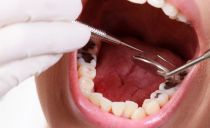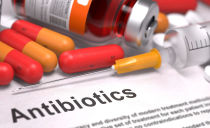Chips on teeth: why teeth break off, what to do, methods of treatment
If a person has broken off a piece of the front or chewing tooth, the main thing that he should not do is to ignore the chip. Otherwise, you can lose the entire tooth. Solve the problem on your own, without qualified help, too, will not work. The most reasonable solution is to consult a dentist as soon as possible and restore the integrity of the dental unit.
Content
Why do teeth crack
Enamel is one of the hardest tissues of the human body. It consists of:
- inorganic substances (about 96%);
- water (about 3%);
- organic substances (1%): enamelins, amelogenins.
Enamel thickness can reach 2.5 mm, regardless of the gender of the patient. This tissue does not contain collagen, therefore it is incapable of regeneration. With age and with a lack of vitamins, it becomes thinner, as a result of which even an ordinary apple can cause tooth enamel chips.
Chipped teeth appear for several main reasons. If the dentist can identify the cause of the defect, the treatment will be effective, otherwise further dental problems may occur. The standard reasons why pieces of teeth fall off include:
- mechanical damage due to injury, falling, biting off too hard foods (nuts, caramel);
- weakened enamel;
- hormonal imbalance;
- demineralization of dental tissues - enamel and dentin;
- low acidity in the oral cavity;
- damaged seal;
- abnormal bite: deep, gnatic, cross;
- the presence of dental diseases: pulpitis, caries, periodontal disease;
- weak immune system.
If the doctor correctly diagnoses the cause of cleavage on the tooth, he will not only be able to correct the existing defect, but also prevent the further formation of dental pathologies.
Symptoms and Diagnosis
The victims will quickly learn about the appearance of a chipped tooth on the front tooth. This defect is clearly visible, therefore, it is easily detected even in the absence of pain. It is more difficult to detect damage to the posterior molar: part of the enamel or seal can be broken off and accidentally swallowed with food, and microcracks are not visible to the naked eye at all, so a person should focus not only on the visual characteristics of the dentition, but also on the sensations during conversation and eating .
If a person has lost a part of the tooth, he can find out about it by the following symptoms:
- hypersensitivity to cold or hot;
- pain on palpation;
- slight swelling.
The first place in diagnosing the cause of cleavage is a routine visual inspection. The dentist collects an anamnesis, clarifies the circumstances in which the defect occurred, and examines the problem area. In most cases, the cause is identified immediately, so additional diagnostics are required only occasionally.
If it is difficult for the dentist to establish the cause of the chip during a routine visual examination, you will have to resort to additional diagnostic methods:
- radiovisiography;
- CT scan;
- dental camera images (allow you to find the deepest caries);
- study of tissues in a dental microscope;
- Apex locator pulp examination;
- laboratory tests of a blood test.
Types of Chips
All dental chips can be divided into several varieties:
- microcrack on enamel (it is easiest to fix);
- enamel chips;
- dentin cleavage;
- cleaved to the pulp chamber.
Lack of dental care in all these cases can lead to a complete loss of a split tooth.
First aid at home
If a person falls off a piece of tooth, the list of actions that he can perform at home will depend on the nature of the defect. If a person does not feel pain and severe discomfort, then he can just make an appointment with his dentist or make an appointment with the doctor on duty. If, due to cleavage, a tooth became ill, blood started to flow, and the gum inflamed, then before a visit to the dentist you can:
- relieve pain painkillers: Ketanov, Nurofen, Ibuklin, Analgin;
- rinse your mouth with herbal infusion or a solution of soda with salt;
- carefully close the cleaved place (with cotton wool or chewing gum);
- apply a gauze or cotton swab to stop the blood;
- if it gets worse, but there is no way right now to call an ambulance or contact a dentistry clinic - take an anti-inflammatory drug.
Methods of restoration and treatment of chipped tooth enamel
Some patients are afraid to go to the dentist, because they think that he will immediately remove the broken tooth. But the first thing a dentist will do with a tooth that has broken off is to try to save it (with the exception of wisdom teeth).
If the dental root is not inflamed, the dentist will not remove the molar just because of its cleavage. But the longer the patient postpones the visit to the doctor, the more likely the tooth is infected with tooth decay and its loss.
Classic treatment
The treatment of chipped teeth depends on the nature of the damage. The following methods are distinguished:
- Extension using composite materials. Suitable in the presence of microcracks and minor chips on the front teeth. The material is applied directly to the damaged, previously prepared enamel area. The procedure allows you to restore a tooth in one visit to dentistry.
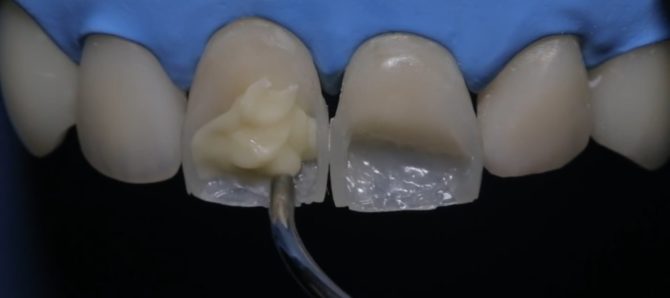
- Restoring the shape of the tooth with dental tabs. This method is used if half of the tooth has broken off, and chewing function is impaired. It consists in installing volume fillings on the injured area and is used only for the treatment of chewing teeth.
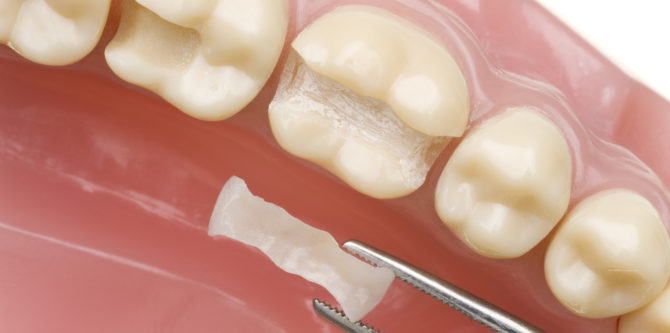
- Installation of tooth veneers and lumineers imitating tooth enamel. The method is effective for minor dental injuries on the front teeth and consists in gluing thin overlays to the prepared “facial” part of the tooth.
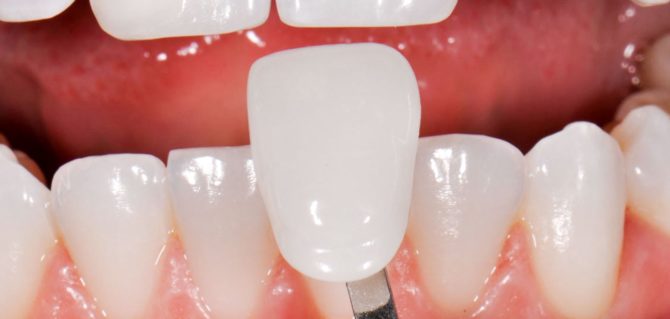
- Setting crowns necessary if the tooth is badly damaged (half of the crown or only the roots are left). During the procedure, resection of the pulp is carried out, the cavity is polished and cleaned, after which it is sealed, and a crown is installed.
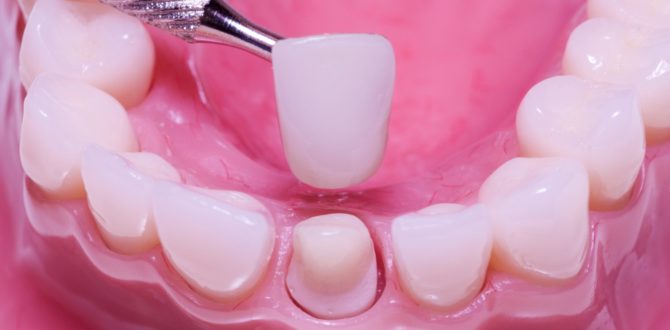
- Implantation. This method is used if you have to remove a tooth. Its essence lies in the fact that a dental prosthesis replaces the tooth root is implanted in the bone tissue of the jaw, and a crown is placed on it.
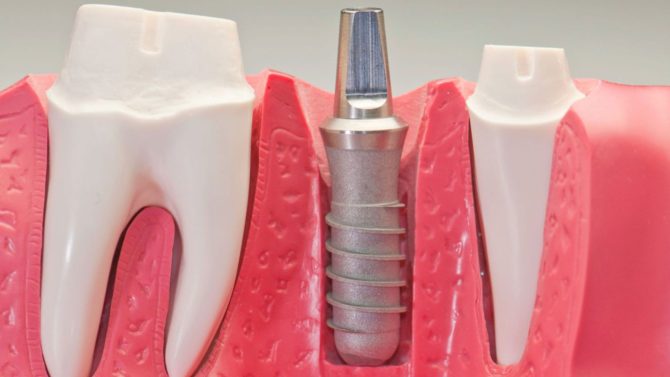
Simultaneously with the treatment of cleavage, it is indicated to correct the patient's bite in order to minimize the risk of further development of the pathology.
Enamel restoration
If damage is detected at an early stage and affects only the surface layer of the tooth - enamel, then you can try to restore it. There are two main methods of enamel restoration:
- remineralization;
- fluoridation.
Remineralization
When using this method of tooth restoration, its upper dental layer is treated with special preparations with microelements. The problem molar is covered with a special protective film and does not collapse under the influence of external factors.
Fluoridation
In this case, the tooth surface is coated with preparations containing fluorine.The procedure can be carried out at home, after consulting with your doctor. With serious dental pathologies, this method is not used.
Innovative Recovery Technologies
If the patient has broken off a part of the tooth, the doctor may suggest that he eliminate the defect with:
- fiberglass, which has excellent characteristics and most naturally imitates natural tooth enamel;
- Glasspan technology, which consists in restoring the front teeth using a ceramic ligament;
- functional and cosmetic restoration of spall areas.
Chips during pregnancy: why and what to do
If as a result of hormonal adjustment and leaching of calcium in a pregnant woman, a piece of tooth breaks off, she should immediately consult a dentist. You can undergo dental treatment from the 12th week of pregnancytherefore, if a woman has split a part of her tooth, she has no reason to procrastinate and endanger herself and the child.
Any crack on the enamel can cause tooth decay, pulpitis and other dental diseases, which in the future will have to be treated with strong anesthetics and antibiotics. Therefore, it is better to restore the chipped part of the tooth immediately after its damage.
Halogen lamps and burs are not harmful to the pregnant woman. If a small piece has broken away from the tooth, then you can treat it without anesthesia, otherwise you will need to warn the doctor about pregnancy so that he picks up an anesthetic drug without adrenaline. If the broken tooth is not cured before the baby is born, then the newborn baby may develop dysbiosis or other caries-related illness.
Chipped milk teeth
In young children, milk (and sometimes molar) teeth are often chipped. The most common cause is bumps or falls to the floor. If the child is injured, you should reassure him, and then contact the dental clinic. A milk tooth will be cured or permanently removed depending on the severity of the pathology. Leave a chip without attention is impossible.
Even a small crack in the enamel can cause inflammation in the oral cavity. With it, tonsillitis and frequent acute respiratory viral infections can be associated. Due to cleavage, there is a risk of developing pathologies of the digestive system and respiratory system. The neglected caries, which appeared on milk teeth due to chips and cracks, can lead to problems with molars and malocclusion.
Broken tooth under the crown
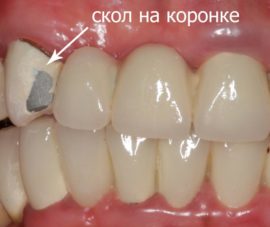 Signs of chipping or breaking a tooth under a crown:
Signs of chipping or breaking a tooth under a crown:
- a crown with a stump broke off or half of it;
- the crown staggers at the slightest mechanical impact;
- the tooth under the crown began to hurt;
- swollen gums.
If only a piece of tooth breaks off, then it can be saved. But the old crown will definitely have to be thrown away, as:
- the crown is damaged from the moment of breaking;
- during the dental treatment, additional procedures will be required that will change the physical characteristics of the crown.
A tooth with a chipped crown is treated in standard ways and closed with a new crown.
What you can’t do if the tooth is chipped and dropped
Here is a list of what you can’t do if a piece of chewing or front tooth has broken off:
- rinse the oral cavity with alcohol-containing drinks;
- glue the enamel pieces back on the chewing surface;
- drink antibiotics to prevent inflammation;
- smear the gums and the cleaved area with green;
- plug the hole with cotton wool and forget about it.
Prevention
The most common reasons why teeth are broken off are insufficient oral hygiene, vitamin deficiency and excessive mechanical (chewing) stress. Therefore, as a preventive measure should:
- quit smoking, as the harmful substances contained in cigarette smoke adversely affect the condition of the enamel;
- eat right;
- protect tooth enamel, do not crack nuts and do not click seeds;
- take vitamins and minerals;
- visit the dentist for preventive purposes.
What should be done if the enamel on the tooth has broken off or the tooth itself has broken, only a dentist can say, given the nature of the pathology. If a tooth is damaged, immediately consult a dentist for qualified medical help.

